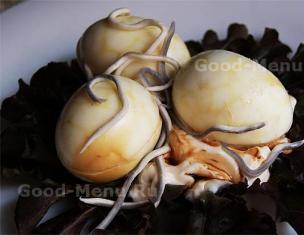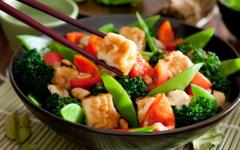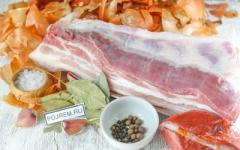Beef liver is very healthy and nutritious. This is one of the most useful by-products.
The liver contains:
- 70% water;
- 3.5% fat;
- 17.8% protein;
- And also amino acids and many vitamins.
The liver contains more B vitamins than many other foods, as well as A, D, E, K. It contains a lot of iron, phosphorus, copper, potassium, sodium, magnesium, calcium, and chromium.
An important factor is that the liver contains a lot of protein, and it contains twice as much cholesterol as beef, but the fat in the liver is half that of beef.
Raw beef liver: calories
You might be wondering how many calories are in beef liver? Its calorie content is 127 kcal per 100 grams. Therefore, liver will be an excellent alternative to beef.

Who benefits from beef liver?
It is recommended to eat liver for those who suffer from anemia and kidney diseases; its consumption strengthens the immune system. And the minerals it contains help the functioning of the brain and other internal organs. It is an excellent antioxidant, helping to cleanse our body of toxins. Potassium contained in the liver will remove excess fluid and strengthen your nerves and cardiovascular system.
Vitamin A is very beneficial for the eyes. The liver also perfectly tones and helps restore strength and energy.
But you need to choose this wonderful product correctly: it should not have an unpleasant odor, and its color in adult animals is dark red with a brown tint. Calves will have lighter livers. Of course, it would be better to buy veal liver.
The surface of the liver should look smooth and shiny, without damage.

Ready beef liver: calorie content
Boiled liver’s calorie content is almost the same as fresh liver – 125 kcal. It may not be as tasty as fried, but liver processed in this way is perfect for salads, pates and a variety of snacks. Its neutral taste perfectly complements other products, and chefs respect it for this.
Tip: before cooking, put the liver in milk for an hour or two, and then it will become even tastier and the bitterness will go away from it.
Well, fried liver, naturally, has more calories than fresh liver, and it will contain more fat and protein. The calorie content of fried liver is approximately 200 kcal per 100 grams.
It’s difficult to call this dish dietary, but you shouldn’t refuse such processing either. Sometimes you can arrange a holiday for yourself and prepare the well-known liver cake with fried onions and carrots. But only if you do not have exacerbations of diseases of the liver, kidneys and gastrointestinal tract.

But stewed liver is the golden mean in terms of benefits and taste. Liver processed in this way will have a calorie content of 117 kcal per 100 g. Stewed liver has a delicate taste, which pleases many gourmets.
Basically, it is stewed in milk or vegetable sauce, or with the addition of sour cream. The important point is not to add foods that contain a lot of fat, otherwise the calorie content will immediately increase and this liver will no longer be the golden mean.
Before cooking, the liver must be cleaned of film and bile ducts and rinsed thoroughly. If you don’t like something on its surface, remove it.
The liver should not be fried or boiled for long, otherwise it will become tough and tasteless; it should also be fried over low heat.
The liver goes well with pickled cucumbers, both separately and if you stew it with them.
Eat healthy and tasty, and then nothing threatens your figure.
Video on the topic of the article
3.8 out of 5
When prepared correctly, liver dishes can become a decoration for any table. The calorie content of fresh liver is relatively low and averages 125-130 kcal. This product is lower in calories than meat, therefore, as a valuable source of protein, amino acids, vitamins and minerals, it can be included in the menu of people struggling with excess weight in reasonable quantities.
The liver is useful for pregnant and lactating women, people engaged in intense physical labor, as well as children during the period of active growth and puberty.
At the same time, despite the moderate calorie content of the liver, you should not get too carried away with this product, since it contains quite a lot of cholesterol and other substances that in large quantities can be hazardous to health.
The most commonly used foods are pork, beef and chicken livers. The calorie content of the liver of these species is in the range of 105-150 kcal. Turkey, duck, and goose livers are considered delicacies and are used much less frequently. The calorie content of the liver of these birds is extremely high and ranges from 275 kcal (turkey liver) to 415 kcal (duck and goose liver).
Interestingly, the calorie content of chicken liver is approximately equal to the energy value of chicken meat. The caloric content of pork liver is three times lower than the caloric content of pork, and the caloric content of beef liver is two times lower than the caloric content of beef. And in terms of mineral and vitamin composition, liver is several times superior to meat.
Comparison of caloric content of beef liver and caloric content of pork liver
The calorie content of the liver of different animals, although the tastes are similar, varies significantly. There are also differences in the composition of nutrients, minerals and vitamins.
The calorie content of pork liver, oddly enough, is the lowest of all types of this product - only 109 kcal per 100 g of product. This is due to the low fat content: no more than 4 g per 100 g of product. Pork liver contains a lot of protein - up to 22-23 g. The carbohydrate content does not exceed 2-3 g. Pork liver is rich in vitamins A, E, H, PP, C, B vitamins. The high content of micro- and macroelements such as molybdenum, iodine, potassium, iron, calcium.
The calorie content of beef liver is higher than pork liver, reaching 127-130 kcal. The amount of protein and fat in beef and pork liver differs insignificantly. But beef liver contains slightly more carbohydrates - 2-3 g. Beef liver is highly valued due to its very high content of B vitamins, vitamins A, H, PP, C, beta-carotene, and choline. Speaking of minerals, it should be noted that beef liver is richest in copper, iron, zinc, chromium, selenium, molybdenum, cobalt, chromium, and phosphorus.
Both beef and pork liver should be eaten fresh. Long-term freezing, and especially repeated freezing and thawing of the product, leads to a decrease in taste and loss of many nutrients.
Calorie content of chicken liver and its composition

The calorie content of chicken liver exceeds the calorie content of beef and pork liver and is 140 kcal.
At the same time, chicken liver has a particularly delicate taste and is easily absorbed by the body. Chicken liver contains about 20 g of protein per 100 g of product, approximately 6-7 g of fat. There are practically no carbohydrates in this product.
Compared to pork and beef liver, chicken liver contains slightly less cholesterol, and this is undoubtedly a big plus. The main advantage of chicken liver is its high content of vitamin A, B vitamins, and especially vitamin B9 - folic acid. It is necessary to maintain immunity, development and normal functioning of the circulatory system. The human body does not synthesize folic acid.
Chicken liver contains a lot of iron, calcium, phosphorus, and magnesium.
Calorie content of cooked liver
Since the liver has a delicate consistency and contains a lot of protein, it reaches the readiness stage very quickly when cooked. If the cooking time is too long, the taste of the product will noticeably deteriorate and the liver will become tough.
Liver is very popular in the cuisines of many peoples of the world, and there are a huge number of recipes for its preparation. Naturally, as a result of culinary processing, the calorie content of the liver undergoes some changes. Various pates are prepared from boiled liver. On average, liver pate contains 315 kcal. Fried, stewed and baked liver is very tasty.
During the frying process, the liver decreases in volume, losing moisture, therefore, the concentration of substances in the product increases. In addition, during the frying process, the liver absorbs a certain amount of oil. Therefore, the calorie content of fried liver is very significant, and this product cannot be considered dietary. Thus, the calorie content of fried beef liver can reach 290-300 kcal. Fried pork liver has a lower energy value - about 220 kcal. And chicken liver absorbs less oil when frying than pork and beef, so the calorie content of fried chicken liver is no more than 185-190 kcal.
The calorie content of stewed liver is significantly lower than that of fried liver..
Thus, the calorie content of stewed liver of different types is:
beef liver – 117-120 kcal;
pork liver – 10-105 kcal;
chicken liver – 140-150 kcal.
The lowest calorie content will be boiled or grilled liver.
Most types of liver have a slight bitterness. To ensure that the bitterness disappears completely, it is recommended to soak the liver in milk for 1-2 hours before cooking.
Despite the rich content of vitamins and minerals, high nutritional value and lower calorie content of liver than meat, older people with high cholesterol levels should limit the amount of this product in their diet. There is no need to completely abandon it. The optimal consumption would be 100-150 g of liver per week.
The liver of animals consumed as food is rich in copper, iron, zinc, calcium, sodium, phosphorus, iodine, magnesium and other trace elements, which makes it extremely useful. It improves blood composition, increases immunity, strengthens bones, teeth, stimulates brain activity, improves the functioning of the thyroid gland and nervous system.
The liver also contains vitamins A and E, which improve the condition of the skin, hair and nails and nourish the organs of vision, and vitamins PP and K, which strengthen blood vessels and normalize blood sugar and cholesterol levels, and potassium, which strengthens the heart. In addition, it is rich in vitamin C, vitamin D, and contains vitamin H, which improves memory and attention and promotes nail and hair growth and skin health. It also contains a lot of B vitamins, which normalize metabolic processes in the body, improve the activity of the brain and nervous system, increase efficiency and resistance to stress, and promote good mood and sound sleep.
These vitamins are also very useful for pregnant and lactating women, as they contribute to the normal development of the fetus and child. Choline contained in the liver regulates insulin levels in the blood and prevents the formation of fatty tissue.
The main source of liver calories is proteins. It contains about 18% of them, carbohydrates - about 5-6%, fats - within 4-5%. Liver is also rich in amino acids - lysine, tryptophan, methionine, etc. Liver is useful for patients with diabetes and atherosclerosis, it prevents the occurrence of anemia, it is useful for older people to use to maintain the health of the heart, blood vessels, joints and nervous system. Heparin, contained in the liver, regulates blood clotting, thereby helping to prevent myocardial infarction. The liver is also useful for urolithiasis.
Calorie content of beef liver
Beef liver improves the body's immunity and regenerative powers; it is useful for burns, kidney diseases and infectious diseases, as well as diseases of the nervous system. It is also recommended for athletes and those who lead an active lifestyle.
The calorie content of beef liver ranges from 100 to 130 kcal per 100 g and depends on the age of the animal and the fat content in it. The calorie content of fried cow liver is 205-215 kcal per 100 g. The calorie content of fried liver with onions is from 110 to 120 kcal per 100 g. The calorie content of boiled beef liver is about 125 kcal per 100 g.
Boiled beef liver may be slightly bitter: to get rid of the bitterness, it is soaked in milk before cooking - this does not affect the energy value, but makes the liver softer and tastier. The calorie content of stewed beef liver is 117 kcal per 100 g, stewed in sour cream – 133 kcal per 100 g.
Chicken liver calorie content
Chicken liver is softer than beef liver and cooks faster. It makes very tender and tasty pates. The peculiarity of chicken liver is its high content of folic acid (vitamin B9), which is extremely beneficial for the nervous system. It also contains a lot of vitamin A. Just 100 g of chicken liver contains the daily requirement of iron. This product is useful for weakened vision, decreased performance and fatigue, as well as lung diseases.
The calorie content of chicken liver is about 140 kcal per 100 g due to a slightly higher fat and protein content than beef liver. The calorie content of fried chicken liver is 153-185 kcal per 100 g - it depends on the amount of fat used in the preparation of this product. The calorie content of stewed chicken liver is 135-150 kcal per 100 g.
Calorie content of pork liver
The younger the pig whose liver you use for food, the more tender and tastier the liver will be. It is covered with a film that must be removed before cooking. Pork liver is used to prepare various dishes - pates, cutlets, minced meat, even liver cake, and is also eaten stewed, fried and baked. If you are afraid that pork liver will be tough, soak it in milk or stew in sour cream - this will make it softer and more tender. Pork liver is often bitter (especially the liver of adult animals), so before cooking it must be soaked in water, milk or sauce for a couple of hours.
Pork liver contains almost all the amino acids necessary for the human body, including essential ones. It is recommended for people suffering from atherosclerosis, diabetes and anemia.
The calorie content of pork liver is about 110 kcal per 100 g. It has a lower fat content, but more carbohydrates than beef or chicken liver. In terms of protein content, it is slightly inferior to chicken liver.
The calorie content of fried pork liver is 220 kcal per 100 g; it can be reduced by not using fat during frying or by using very little fat (for this you will need a non-stick frying pan). The calorie content of pork liver stewed with onions, carrots and sour cream is 133 kcal per 100 g.
What can you cook from liver?
 Berlin-style liver with apples is a very simple, delicious dish made from beef liver. Take 0.5 kg of liver, cut into portions and lightly beat through film, roll in flour, salt and pepper and start frying in a frying pan with vegetable oil. After frying all the pieces, place them on a paper napkin to remove excess fat. Do not drain the oil from the frying pan - it will come in handy later.
Berlin-style liver with apples is a very simple, delicious dish made from beef liver. Take 0.5 kg of liver, cut into portions and lightly beat through film, roll in flour, salt and pepper and start frying in a frying pan with vegetable oil. After frying all the pieces, place them on a paper napkin to remove excess fat. Do not drain the oil from the frying pan - it will come in handy later.
Cut two green apples into pieces, after peeling the skin. Now fry the apples in the oil in which the liver was fried until medium soft - they should be saturated with the liver spirit. After frying the apples, remove them, and now in the same oil with apple and liver juices, fry the onion cut into rings with the addition of curry and paprika until half cooked.
Then place the apples in layers on the dish, then the liver and then the onions. Place in a microwave at 700-800 watts for 2-3 minutes or in an oven preheated to 175 degrees for 5-7 minutes, then remove, garnish with fresh herbs and serve. The calorie content of Berlin-style liver is only 89 kcal per 100 g.
Beef liver in sour cream is very easy to prepare. You will need 0.5 kg of liver, 1 cup of sour cream, an onion, a glass of chicken broth, vegetable oil, pepper and salt. You can use chicken liver - it cooks even faster.
Cut the liver into pieces, roll in flour, pepper and salt and fry in a frying pan until golden brown. Place the liver in a saucepan, add broth and bring to a boil; add sour cream and simmer over low heat. Fry the onion in oil until golden brown and add to the liver. When the liver becomes soft, the dish is ready.
The calorie content of stewed liver in sour cream is 165 kcal per 100 g. As a side dish you can serve rice, buckwheat or pea porridge, mashed potatoes, boiled pasta or fresh vegetable salad.
If you liked this article, please vote for it:(26 Votes)
Beneficial properties of the liver
One of the most useful by-products is liver. This is primarily due to the fact that it contains a huge amount of easily digestible proteins, as well as a large percentage of iron and copper, also in an easily digestible form. Also in the liver high vitamin contentA, which helps the body maintain healthy kidneys, brain and vision, and also has a positive effect on human skin, hair and teeth. In addition, along with a serving of liver, your body will receive calcium, sodium, magnesium, phosphorus and zinc, vitaminsBC. Taken together, this leads to the fact that liver is an indispensable product, especially for young children. For people suffering from atherosclerosis and diabetes, the liver is often prescribed as a rich source of nutrients.
Be sure to pay attention to this product if you are prone to vascular thrombosis. The liver contains heparin, which normalizes blood clotting. It should be noted that liver is an excellent dietary product. Despite the high content of proteins and minerals, it contains very few calories.
Liver calories
Calorie content of cooked liver
It should also be mentioned that, although the liver itself is a dietary product, depending on the choice of the method of its heat treatment, the calorie content of the product can vary greatly. So, the most healthy is boiled liver, and the least healthy is fried in oil. Below is a table with methods for processing liver, as well as its calorie content. For accuracy everywhere beef liver indicated.
Liver is used as an ingredient in various dishes. But please note that the calorie content of cooked liver and the calorie content of the dish will certainly vary. For example, calorie content of liver stewed in sour cream— 133 kcal.
| product | calorie content | squirrels | fats | carbohydrates |
| chicken liver | 136 kcal | 19.1 g | 6.3 g | 0.6 g |
| boiled chicken liver | 166 kcal | 25.9 g | 6.2 g | 2.0 g |
| fried chicken liver | 210 kcal | 30.8 g | 8.9 g | 2.0 g |
| stewed chicken liver | 164 kcal | 17 g | 5.6 g | 1.7 g |
| goose liver | 412 kcal | 15.2 g | 39 g | 0 g |
| beef liver | 125 kcal | 20 g | 3.1 g | 4.0 g |
| pork liver | 130 kcal | 22 g | 3.4 g | 2.6 g |
Since ancient times, liver has been considered a very healthy and nutritious food product. The calorie content of this product is quite high, it has a unique chemical composition. The product contains cholesterol, essential fatty acids, carbohydrates, proteins, organic acids, vitamins (E, A, PP, C, D, B) necessary for the growth and development of the body, as well as minerals (molybdenum, fluorine, iodine, chromium, phosphorus , chlorine, magnesium, sodium, potassium, iron, calcium, zinc, nickel).
Beef liver: benefits, composition
Of all the existing types of offal, beef liver is the most complete. When purchasing a product, it is important to pay attention to its freshness. The liver cut should be smooth with a fairly uniform structure. Weight must be less than 2 kilograms. The liver of young animals is loose, light brown, with a delicate consistency. But the liver of a mature animal may have a bitter taste. It is recommended to soak this product in milk before use.
Fried beef liver is rich in vitamins A, B, C and E, as well as macro- and microelements. It contains calcium, phosphorus, potassium, sodium, fluorine, magnesium, chromium, manganese, iron, copper, etc. It is recommended for those who suffer from iron deficiency anemia, kidney disease and disorders of the nervous system. Due to its significant thiamine content, beef liver is recommended for smokers. After all, thiamine is famous for its antioxidant properties that protect the body from the negative effects of tobacco. Chromium and heparin are responsible for blood clotting processes, which slightly increase the calorie content of fried beef liver. Vitamins C and D, as well as calcium, perfectly strengthen the musculoskeletal system. The offal is useful for pregnant women, because it contains folic acid.
Pork liver: benefits, composition
Pork liver is very rich in minerals (potassium, fluorine, sodium, calcium, magnesium, iron, chromium, etc.) and vitamins (H, B, A, D, PP, C). It is recommended to eat it stewed.
In terms of taste characteristics, pork liver is tastier than beef liver. It does not require long preparation. This is its main advantage. In terms of usefulness, pork liver is inferior to beef liver. It contains fewer vitamins and minerals and contains cholesterol, which has an adverse effect on the body.









